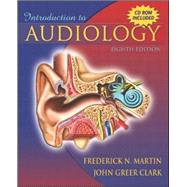
Note: Supplemental materials are not guaranteed with Rental or Used book purchases.
Purchase Benefits
What is included with this book?
I. ELEMENTS OF AUDIOLOGY.
1. The Profession of Audiology.
The Evolution of Audiology.
Prevalence and Impact of Hearing Loss.
Audiology Specialties.
Employment Settings.
Professional Societies.
2. The Human Ear and Simple Tests of Hearing.
Anatomy and Physiology of the Ear.
Pathways of Sound.
Types of Hearing Loss.
Hearing Tests.
Tuning Fork Tests.
3. Sound and Its Measurements.
Sound.
Waves.
Vibrations.
Frequency.
Resonance.
Sound Velocity.
Wavelength.
Phase.
Complex Sounds.
Intensity.
The Decibel.
Environmental Sounds.
Psychoacoustics.
Impedance.
Sound Measurement.
II. HEARING ASSESSMENT.
4. Pure-Tone Audiometry.
The Pure-Tone Audiometer.
Test Environment.
The Patient's Role in Manual Pure-Tone Audiometry.
The Clinician's Role in Manual Pure-Tone Audiometry.
Air-Conduction Audiometry.
Bone-Conduction Audiometry.
Audiogram Interpretation.
Masking.
The Audiometric Weber Test.
Automatic Audiometry.
Computerized Audiometry.
5. Speech Audiometry.
The Diagnostic Audiometer.
Test Environment.
The Patient's Role in Speech Audiometry.
The Clinician's Role in Speech Audiometry.
Speech-Threshold Testing.
Masking for SRT.
Bone-Conduction SRT.
Most Comfortable Loudness Level.
Uncomfortable Loudness Level.
Range of Comfortable Loudness.
Speech-Recognition Testing.
Computerized Speech Audiometry.
6. Objective Tests of the Auditory System.
Acoustic Immittance.
Acoustic Reflexes.
Otoacoustic Emissions (OAE).
Auditory Evoked Potentials.
7. Behavioral Tests for Site of Lesion.
Loudness Recruitment.
The Short Increment Sensitivity Index.
Tone Decay.
Bekesky Audiometry.
8. Hearing Tests for Children.
Auditory Responses.
Identifying Hearing Loss in Infants under Three Months of Age.
Objective Testing in Routine Pediatric Hearing Evaluation.
Behavioral Testing of Children from Birth to Approximately Two Years of Age.
Behavioral Testing of Children Approximately Two to Five Years of Age.
Language Disorders.
Auditory Processing Disorders.
Psychological Disorders.
Developmental Disabilities.
Identifying Hearing Loss in the Schools.
Nonorganic Hearing Loss in Children.
III. HEARING DISORDERS.
9. The Outer Ear.
Anatomy and Physiology of the Outer Ear.
Development of the Outer Ear.
Hearing Loss and the Outer Ear.
Disorders of the Outer Ear and Their Treatments.
10. The Middle Ear.
Anatomy and Physiology of the Middle Ear.
Development of the Middle Ear.
Hearing Loss and the Middle Ear.
Disorders of the Middle Ear and Their Treatments.
Other Causes of Middle-Ear Hearing Loss.
11. The Inner Ear.
Anatomy and Physiology of the Inner Ear.
Development of the Inner Ear.
Hearing Loss and the Inner Ear.
Causes of Inner-Ear Disorders.
12. The Auditory Nerve and Central Auditory Pathways.
Anatomy and physiology of the Auditory Nerve and Ascending Auditory Pathways.
The Descending Auditory Pathways.
Development of the Auditory Nerve and Central Auditory Nervous System.
Summary of the Auditory Pathways.
Hearing Loss and the Auditory Nerve and Central Auditory Pathways.
Disorders of the Auditory Nerve.
Disorders of the Cochlear Nuclei.
Disorders of the Higher Auditory Disorders.
Tests for Auditory Processing Disorders.
Diagnostic Limitations.
Therapeutic Management.
13. Nonorganic Hearing Loss.
Terminology.
Patients with Nonorganic Hearing Loss.
Tests for Nonorganic Hearing Loss.
Management of Patients with Nonorganic Hearing Loss.
IV. MANAGEMENT OF HEARING LOSS.
14. Amplification/Sensory Systems.
Hearing Aid Development.
Hearing Aid Circuit Overview.
Characteristics of Hearing Aids.
Binaural Amplification.
Types of Hearing Aids.
Selecting Hearing-Aid Candidates.
Dispensing Hearing Aids.
Verifying Hearing Aid Performance.
Hearing Assistance Technologies.
15. Audiological Treatment.
Patient Histories.
Referral to Other Specialists.
Audiological Counseling.
Management of Adult Hearing Impairment.
Management of Childhood Hearing Impairment.
The Deaf Community.
Management of Tinnitus.
Hyperacusis.
Vestibular (Re)habilitation.
Multicultural Consideration.
Glossary.
The New copy of this book will include any supplemental materials advertised. Please check the title of the book to determine if it should include any access cards, study guides, lab manuals, CDs, etc.
The Used, Rental and eBook copies of this book are not guaranteed to include any supplemental materials. Typically, only the book itself is included. This is true even if the title states it includes any access cards, study guides, lab manuals, CDs, etc.